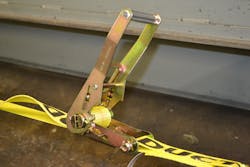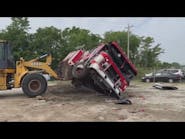University of Extrication: Tie-Down Ratchet Strap Unit Safety
Topic: Tie-down webbing safe operations
Objective: The rescue team will better understand proper utilization of 2-inch-wide tie-down webbing and ratchet units.
Task: The rescue team shall review their safety procedures when using 2-inch-wide tie-down ratchet strap units at a rescue incident.
There are several important safety considerations that rescue teams must follow when using 2-inch-wide tie-down ratchet strap units. In this article, we will review three of the most urgent issues.
Mandrel wrapping
The Maryland-based Web Sling & Tie Down Association, the largest nonprofit technical organization dedicated to the safe operation of all synthetic web slings and tie downs, advises users that when using ratchet web tie-downs, a minimum of two and a maximum of four wraps of webbing shall be wound on the mandrel or center core of the ratchet.
The Association found that less than two wraps of webbing around the mandrel may result in webbing slippage under load. If more than four wraps are used, it can place unnecessary strain on the ratchet device and actually reduce the working load limit (WLL) of the unit.
Destructive testing revealed that if the webbing is run through the slot of the mandrel and pulled tight by hand, as we normally are taught to do, it is all but impossible to get even more than one full wrap of webbing on the mandrel as the unit is tightened.
To accomplish the number of wraps that the Association recommends, there must be initial slight slack in the webbing prior to cranking the ratchet handle. This slack allows the mandrel to spin and the webbing to settle around the mandrel for the two wraps mentioned. If pulled too tight, the tool will not allow enough wraps. Conversely, too much slack and the mandrel will load up with webbing before you even get the webbing tight. It is a delicate balance that rescuers should practice until they become proficient when using tie-down ratchet strap units.
Handle position
When the handle of a ratchet tie down unit is closed, a gap on each side of the handle frame engages in the moveable slide bar of the ratchet device. The handle, when down or closed, locks the slide bar and the mandrel or core of the tool in position. We conducted research to see if it makes any difference in the WLL of the tie-down tool whether the handle is open or closed.
To evaluate this issue, laboratory testing was conducted on ratchet units with 2-inch-wide webbing. In one series of tests, the units were pulled to their breaking strength failure point with the ratchet handles in the closed and locked position. In other testing, the handles of the ratchet units were left in the up or unlocked position.
What difference did it make? In these controlled laboratory tests, the results showed that it made essentially no difference at all in the failure of the ratchet tool. It seems breaking strength is breaking strength regardless of handle position.
Knowing this, rescuers should agree that once the initial tightening of a ratchet has been accomplished, the handle should be placed down in the closed and locked position. The reality is that this is just a “nice to do” safety action and not really a “must-do” task. Err on the side of caution and keep the handle down for safety.
Hook position
When a 2-inch-wide ratchet tie-down unit is pulled to its breaking strength point, the failure occurs in an instant. During this split-second of destruction, the twin hook at the end of the ratchet tie-down that fails will violently fly off. But, in which direction does it fly? We conducted tests to see if the direction may be predictable.
During laboratory testing, when the back of a hook was facing down and the opening of the hook facing up, at failure, the hook impacted the floor of the test lab hard—in some cases violently enough to cause damage to the concrete floor.
When the back side of a hook was facing upward at the breaking strength failure point, the hook flew upward as the chain it was attached to failed. One hook flew off so violently that it impaled into the heavy steel mesh protective cover over the testing machine in the lab.
Although we do not intend to overload a hook, ratchet device or chain to the point of failure, it is advisable to secure every hook with the back side, or smooth side, facing down toward the ground. This safety action is so that if a failure of any component of the system were to occur, the hook would go down and not upward. Failure is never a good thing, but a hook flying down is always be a better situation than one flying up and away.
In sum
On the ratchet strap units that rescuers use at crash scenes, a minimum of two and a maximum of four wraps of webbing shall be wound on the mandrel or center core of the ratchet. The handle should be placed in the down position. The twin hook should be facing down with the open side of the twin hook upward. While this is not how these ratchet units are found when initially purchased, it is how each one should be modified for vehicle rescue applications.
Mandrel Wrapping
- A wrap places at least one full layer of webbing around the mandrel
- Two to four wraps of webbing will appear as four to eight layers of webbing around the mandrel
- It is almost impossible to get four full wraps of 2-inch-wide webbing around the mandrel of a tie-down unit.

Ron Moore
RON MOORE, who is a Firehouse contributing editor, recently retired as a division chief with the McKinney, TX, Fire Department and now serves with Prosper, TX, Fire Rescue. He self-published the Vehicle Rescue 1-2-3 training manual and serves as the forum moderator for the extrication section of Firehouse.com . Moore can be contacted directly at [email protected].






